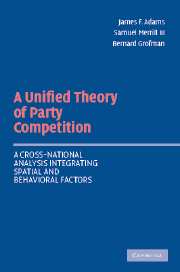 A Unified Theory of Party Competition
A Unified Theory of Party Competition Published online by Cambridge University Press: 04 December 2009
Candidate Strategies for a Policy-only Turnout Model
Here we assess two alternative voting models concerning candidate strategies that place Hypotheses 1 and 2 (introduced in section 8.2) in perspective. Both the illustrative arguments from Chapter 7, section 7.3 and the results presented in prior spatial modeling studies (e.g., Riker and Ordeshook 1968; Hinich and Ordeshook 1970; Enelow and Hinich 1984; Erikson and Romero 1990; Anderson and Glomm 1992) suggest the following hypotheses for margin-maximizing candidates:
H3: For a policy-only turnout model – that is, one that omits measured nonpolicy variables – the two candidates' optimal policy positions converge along the policy scales.
H4: For a unified turnout model that omits abstention due to alienation – that is, one in which abstention is specified as being motivated solely by indifference – the two candidates' optimal policy positions converge along the policy scales.
Hypotheses 3 and 4 are important because if they are supported, these results will bolster our central theoretical claim that while the combination of voters' non-policy-related motivations and abstention due to alienation motivates candidate divergence (H1), neither alienation nor nonpolicy motivations alone motivates divergence (H3 – H4).
In contrast to the unified turnout model explored earlier, most spatial modeling studies omit measured nonpolicy variables. First, we evaluate Hypothesis 3, that such a voting model motivates candidates to present convergent policies – the standard result in the spatial modeling literature. In order to explore this hypothesis, we estimated the parameters of a policy-only turnout model for the 1988 ANES that included only respondents' policy evaluations as independent variables. The parameter estimates for this model are reported in Table A8.1.
To save this book to your Kindle, first ensure [email protected] is added to your Approved Personal Document E-mail List under your Personal Document Settings on the Manage Your Content and Devices page of your Amazon account. Then enter the ‘name’ part of your Kindle email address below. Find out more about saving to your Kindle.
Note you can select to save to either the @free.kindle.com or @kindle.com variations. ‘@free.kindle.com’ emails are free but can only be saved to your device when it is connected to wi-fi. ‘@kindle.com’ emails can be delivered even when you are not connected to wi-fi, but note that service fees apply.
Find out more about the Kindle Personal Document Service.
To save content items to your account, please confirm that you agree to abide by our usage policies. If this is the first time you use this feature, you will be asked to authorise Cambridge Core to connect with your account. Find out more about saving content to Dropbox.
To save content items to your account, please confirm that you agree to abide by our usage policies. If this is the first time you use this feature, you will be asked to authorise Cambridge Core to connect with your account. Find out more about saving content to Google Drive.